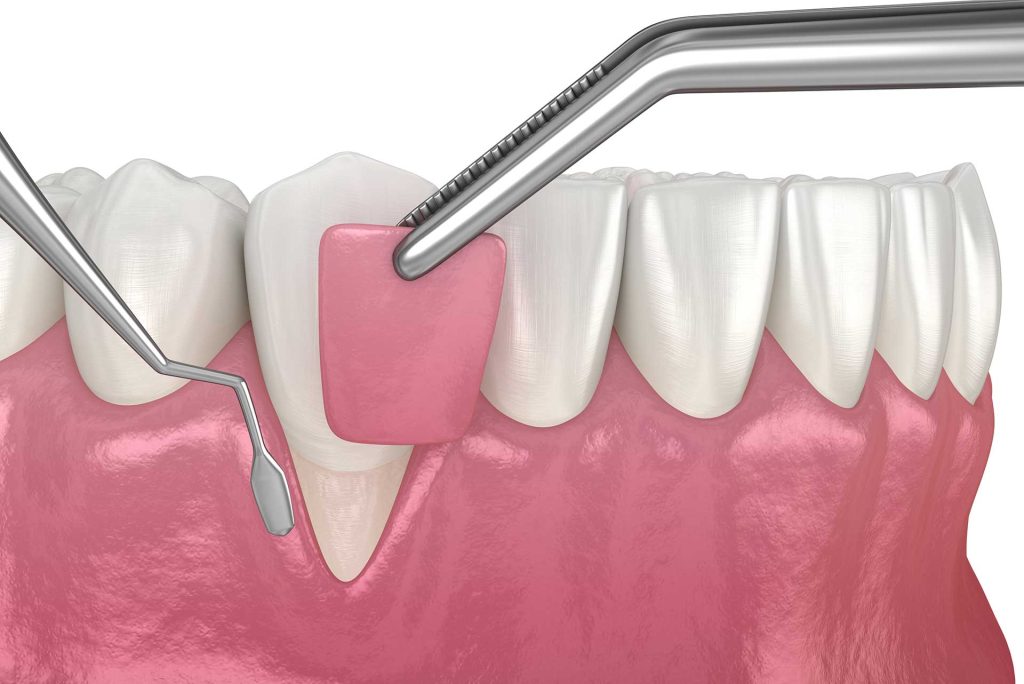Advanced periodontal disease: gum graft and gum disease surgery
Curious to know how we use gum surgery to treat advanced periodontal disease?
For gum disease that has progressed significantly, we will use more sophisticated procedures. They come on top of those typical of other stages (see Dental deep cleaning: scaling and root planning in Mid-town East, New York.)
These include:
- pocket reduction surgery, to eliminate gum pockets
- gum graft surgery to cover exposed roots of your teeth
- bone grafts to replace your teeth’s supporting bone tissue (lost during the process of gum disease)

So, let’s look at gum grafting.
Gum grafts or oral tissue grafts
Has your disease significantly damaged your gums?
If so, then gum surgery will be necessary to prevent further decay and an eventual tooth loss.
How can you tell? For that, you will need to schedule an evaluation. And we strongly advise you to do so if your gums:
- bleed,
- have receded,
- are swollen,
- are tender
Or (and) your teeth are very sensitive to hot and cold temperatures.
But what exactly are gum grafts?
They are tiny portions of oral tissues that we take from a healthy part of your mouth. We then implant them near the base of those teeth (or tooth) that appear longer because of your receding gums. Sometimes we graft tissue from a tissue bank.
With time, the new tissue will:
- fuse with the existing gums, thus protecting your teeth and rebuilding some of the damaged gum tissue
- help the development of new ligament fibers to attach to the roots’ surfaces
You may be wondering why it is important to protect these newly exposed surfaces of your teeth.
It is important to cover your teeth’s lower portions because these surfaces consist of cementum.
Cementum is less hard than your enamel that covers the crown of your tooth. It thus needs protection since it is more prone to wear and decay than enamel. If they are not protected, your teeth will become more sensitive and fragile to attacks by acids, plaque, extreme temperatures, etc.
So, what are the benefits of gum grafts?
Benefits of gum grafting procedures
Tissue grafts will improve your oral health by:
- protecting your teeth’ roots from wear and decay (as they are more fragile than your crowns)
- Doing away with extreme sensitivity since your dental roots will be covered
- Eliminating bad breath
- Stopping gum recession and healing your gums
- Returning your teeth to their normal length. Your smile will be more esthetically pleasant (no more vampire look, if your canines are suffering)
Let’s now move on to another technique. Our periodontist uses it when bacteria’s harmful biochemicals damage the bone supporting your teeth.
Osseous grafts
If gum disease is left unchecked, the bacteria’s destructive process continues to the bone. As a result, the bony socket that supports your teeth weakens, resorbs, and your teeth may become loose.
Our periodontist uses osseous grafts akin to gum grafts. In other words, he will employ it to repair bone tissue destroyed by advanced and continuous gum disease.
So, a bone graft helps to reconstruct the necessary bone support around your teeth (or tooth) and build up your jaw. We take it from a tissue bank or use synthetic bone.
After successful periodontal treatments …
… you will need to do:
- follow-up examinations,
- frequent professional cleanings,
- and ensure that an appropriate brushing and flossing regimen is followed.
This approach will help avoid the return and progression of periodontal disease.
SUTTON PLACE DENTAL ASSOCIATES ON THE WEB






